tire type JEEP CHEROKEE 2020 Owner handbook (in English)
[x] Cancel search | Manufacturer: JEEP, Model Year: 2020, Model line: CHEROKEE, Model: JEEP CHEROKEE 2020Pages: 332, PDF Size: 8.87 MB
Page 201 of 332
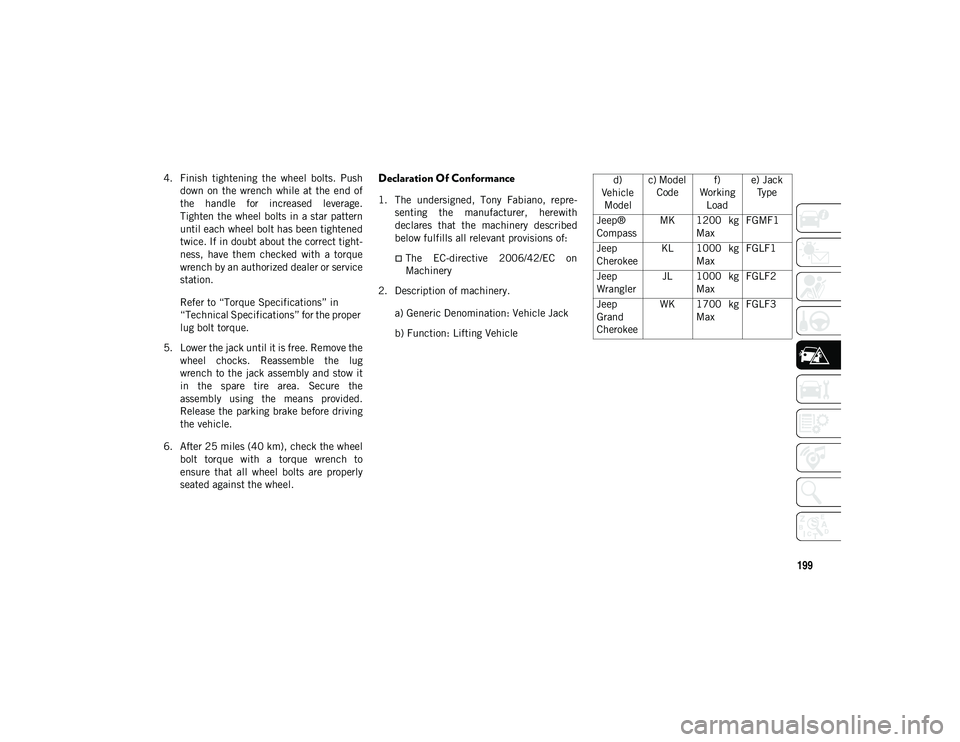
199
4. Finish tightening the wheel bolts. Pushdown on the wrench while at the end of
the handle for increased leverage.
Tighten the wheel bolts in a star pattern
until each wheel bolt has been tightened
twice. If in doubt about the correct tight -
ness, have them checked with a torque
wrench by an authorized dealer or service
station.
Refer to “Torque Specifications” in
“Technical Specifications” for the proper
lug bolt torque.
5. Lower the jack until it is free. Remove the wheel chocks. Reassemble the lug
wrench to the jack assembly and stow it
in the spare tire area. Secure the
assembly using the means provided.
Release the parking brake before driving
the vehicle.
6. After 25 miles (40 km), check the wheel bolt torque with a torque wrench to
ensure that all wheel bolts are properly
seated against the wheel.Declaration Of Conformance
1. The undersigned, Tony Fabiano, repre -
senting the manufacturer, herewith
declares that the machinery described
below fulfills all relevant provisions of:
The EC-directive 2006/42/EC on
Machinery
2. Description of machinery.
a) Generic Denomination: Vehicle Jack
b) Function: Lifting Vehicle d)
Vehicle Model c) Model
Code f)
Working Load e) Jack
Type
Jeep®
Compass MK 1200 kg
Max FGMF1
Jeep
Cherokee KL 1000 kg
Max FGLF1
Jeep
Wrangler JL 1000 kg
Max FGLF2
Jeep
Grand
Cherokee WK 1700 kg
Max FGLF3
2020_JEEP_CHEROKEE_UG_RHD_UK.book Page 199
Page 244 of 332
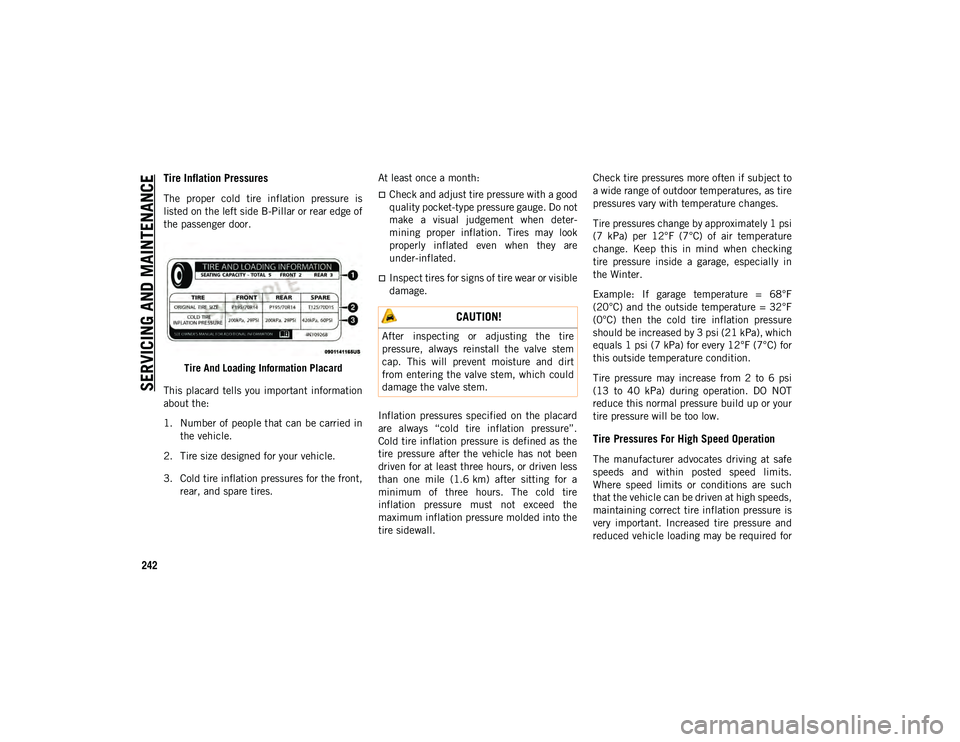
SERVICING AND MAINTENAN
CE
242
Tire Inflation Pressures
The proper cold tire inflation pressure is
listed on the left side B-Pillar or rear edge of
the passenger door.Tire And Loading Information Placard
This placard tells you important information
about the:
1. Number of people that can be carried in the vehicle.
2. Tire size designed for your vehicle.
3. Cold tire inflation pressures for the front, rear, and spare tires. At least once a month:Check and adjust tire pressure with a good
quality pocket-type pressure gauge. Do not
make a visual judgement when deter
-
mining proper inflation. Tires may look
properly inflated even when they are
under-inflated.
Inspect tires for signs of tire wear or visible
damage.
Inflation pressures specified on the placard
are always “cold tire inflation pressure”.
Cold tire inflation pressure is defined as the
tire pressure after the vehicle has not been
driven for at least three hours, or driven less
than one mile (1.6 km) after sitting for a
minimum of three hours. The cold tire
inflation pressure must not exceed the
maximum inflation pressure molded into the
tire sidewall. Check tire pressures more often if subject to
a wide range of outdoor temperatures, as tire
pressures vary with temperature changes.
Tire pressures change by approximately 1 psi
(7 kPa) per 12°F (7°C) of air temperature
change. Keep this in mind when checking
tire pressure inside a garage, especially in
the Winter.
Example: If garage temperature = 68°F
(20°C) and the outside temperature = 32°F
(0°C) then the cold tire inflation pressure
should be increased by 3 psi (21 kPa), which
equals 1 psi (7 kPa) for every 12°F (7°C) for
this outside temperature condition.
Tire pressure may increase from 2 to 6 psi
(13 to 40 kPa) during operation. DO NOT
reduce this normal pressure build up or your
tire pressure will be too low.
Tire Pressures For High Speed Operation
The manufacturer advocates driving at safe
speeds and within posted speed limits.
Where speed limits or conditions are such
that the vehicle can be driven at high speeds,
maintaining correct tire inflation pressure is
very important. Increased tire pressure and
reduced vehicle loading may be required for
CAUTION!
After inspecting or adjusting the tire
pressure, always reinstall the valve stem
cap. This will prevent moisture and dirt
from entering the valve stem, which could
damage the valve stem.
2020_JEEP_CHEROKEE_UG_RHD_UK.book Page 242
Page 245 of 332
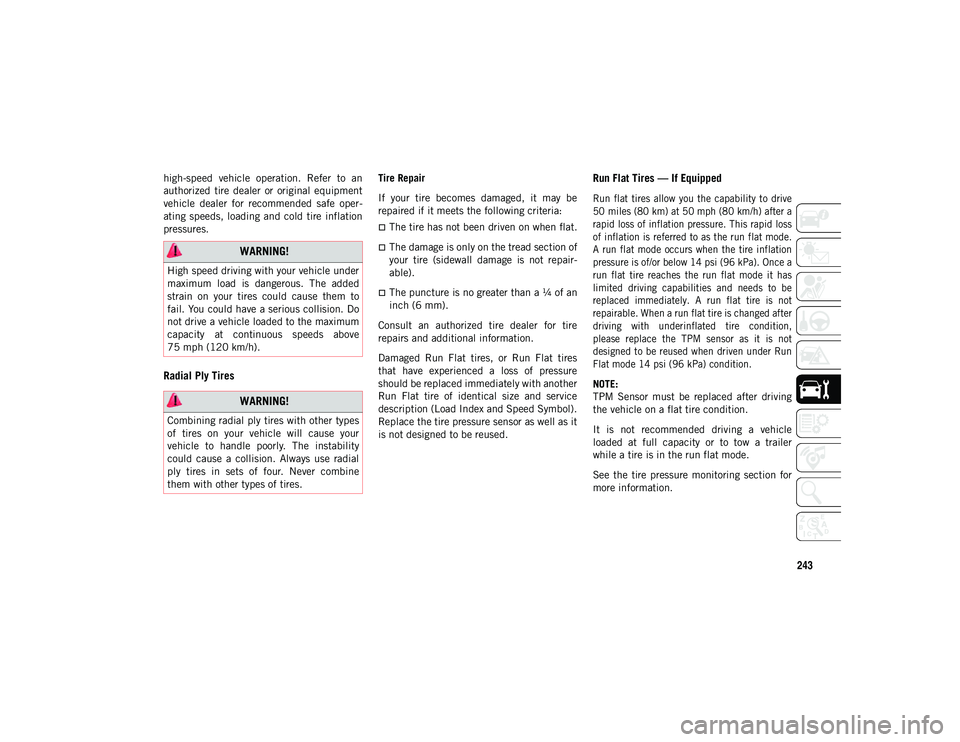
243
high-speed vehicle operation. Refer to an
authorized tire dealer or original equipment
vehicle dealer for recommended safe oper-
ating speeds, loading and cold tire inflation
pressures.
Radial Ply Tires
Tire Repair
If your tire becomes damaged, it may be
repaired if it meets the following criteria:
The tire has not been driven on when flat.
The damage is only on the tread section of
your tire (sidewall damage is not repair -
able).
The puncture is no greater than a ¼ of an
inch (6 mm).
Consult an authorized tire dealer for tire
repairs and additional information.
Damaged Run Flat tires, or Run Flat tires
that have experienced a loss of pressure
should be replaced immediately with another
Run Flat tire of identical size and service
description (Load Index and Speed Symbol).
Replace the tire pressure sensor as well as it
is not designed to be reused.
Run Flat Tires — If Equipped
Run flat tires allow you the capability to drive
50 miles (80 km) at 50 mph (80 km/h) after a
rapid loss of inflation pressure. This rapid loss
of inflation is referred to as the run flat mode.
A run flat mode occurs when the tire inflation
pressure is of/or below 14 psi (96 kPa). Once a
run flat tire reaches the run flat mode it has
limited driving capabilities and needs to be
replaced immediately. A run flat tire is not
repairable. When a run flat tire is changed after
driving with underinflated tire condition,
please replace the TPM sensor as it is not
designed to be reused when driven under Run
Flat mode 14 psi (96 kPa) condition.
NOTE:
TPM Sensor must be replaced after driving
the vehicle on a flat tire condition.
It is not recommended driving a vehicle
loaded at full capacity or to tow a trailer
while a tire is in the run flat mode.
See the tire pressure monitoring section for
more information.
WARNING!
High speed driving with your vehicle under
maximum load is dangerous. The added
strain on your tires could cause them to
fail. You could have a serious collision. Do
not drive a vehicle loaded to the maximum
capacity at continuous speeds above
75 mph (120 km/h).
WARNING!
Combining radial ply tires with other types
of tires on your vehicle will cause your
vehicle to handle poorly. The instability
could cause a collision. Always use radial
ply tires in sets of four. Never combine
them with other types of tires.
2020_JEEP_CHEROKEE_UG_RHD_UK.book Page 243
Page 248 of 332
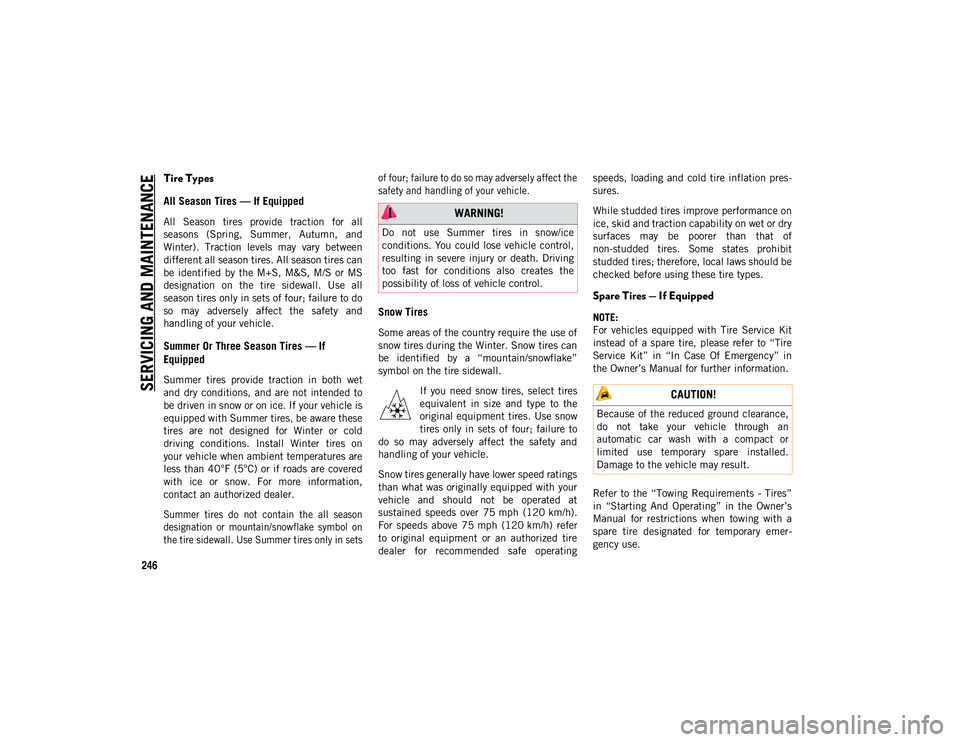
SERVICING AND MAINTENAN
CE
246
Tire Types
All Season Tires — If Equipped
All Season tires provide traction for all
seasons (Spring, Summer, Autumn, and
Winter). Traction levels may vary between
different all season tires. All season tires can
be identified by the M+S, M&S, M/S or MS
designation on the tire sidewall. Use all
season tires only in sets of four; failure to do
so may adversely affect the safety and
handling of your vehicle.
Summer Or Three Season Tires — If
Equipped
Summer tires provide traction in both wet
and dry conditions, and are not intended to
be driven in snow or on ice. If your vehicle is
equipped with Summer tires, be aware these
tires are not designed for Winter or cold
driving conditions. Install Winter tires on
your vehicle when ambient temperatures are
less than 40°F (5°C) or if roads are covered
with ice or snow. For more information,
contact an authorized dealer.
Summer tires do not contain the all season
designation or mountain/snowflake symbol on
the tire sidewall. Use Summer tires only in setsof four; failure to do so may adversely affect the
safety and handling of your vehicle.
Snow Tires
Some areas of the country require the use of
snow tires during the Winter. Snow tires can
be identified by a “mountain/snowflake”
symbol on the tire sidewall.
If you need snow tires, select tires
equivalent in size and type to the
original equipment tires. Use snow
tires only in sets of four; failure to
do so may adversely affect the safety and
handling of your vehicle.
Snow tires generally have lower speed ratings
than what was originally equipped with your
vehicle and should not be operated at
sustained speeds over 75 mph (120 km/h).
For speeds above 75 mph (120 km/h) refer
to original equipment or an authorized tire
dealer for recommended safe operating speeds, loading and cold tire inflation pres
-
sures.
While studded tires improve performance on
ice, skid and traction capability on wet or dry
surfaces may be poorer than that of
non-studded tires. Some states prohibit
studded tires; therefore, local laws should be
checked before using these tire types.
Spare Tires — If Equipped
NOTE:
For vehicles equipped with Tire Service Kit
instead of a spare tire, please refer to “Tire
Service Kit” in “In Case Of Emergency” in
the Owner’s Manual for further information.
Refer to the “Towing Requirements - Tires”
in “Starting And Operating” in the Owner’s
Manual for restrictions when towing with a
spare tire designated for temporary emer -
gency use.
WARNING!
Do not use Summer tires in snow/ice
conditions. You could lose vehicle control,
resulting in severe injury or death. Driving
too fast for conditions also creates the
possibility of loss of vehicle control.
CAUTION!
Because of the reduced ground clearance,
do not take your vehicle through an
automatic car wash with a compact or
limited use temporary spare installed.
Damage to the vehicle may result.
2020_JEEP_CHEROKEE_UG_RHD_UK.book Page 246
Page 251 of 332
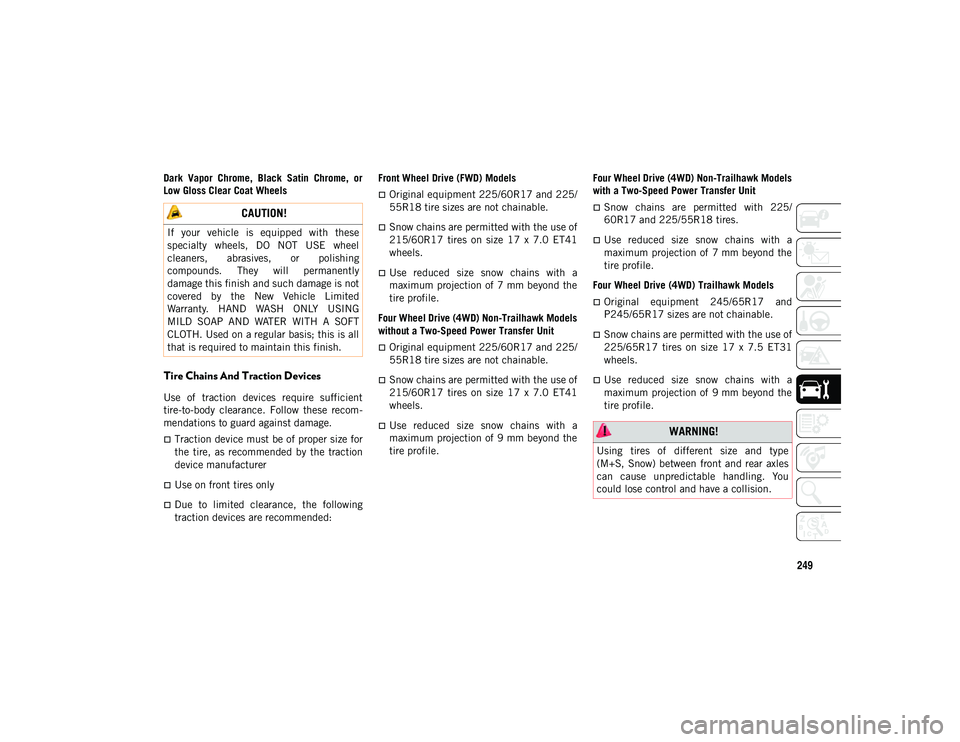
249
Dark Vapor Chrome, Black Satin Chrome, or
Low Gloss Clear Coat Wheels
Tire Chains And Traction Devices
Use of traction devices require sufficient
tire-to-body clearance. Follow these recom-
mendations to guard against damage.
Traction device must be of proper size for
the tire, as recommended by the traction
device manufacturer
Use on front tires only
Due to limited clearance, the following
traction devices are recommended: Front Wheel Drive (FWD) Models
Original equipment 225/60R17 and 225/
55R18 tire sizes are not chainable.
Snow chains are permitted with the use of
215/60R17 tires on size 17 x 7.0 ET41
wheels.
Use reduced size snow chains with a
maximum projection of 7 mm beyond the
tire profile.
Four Wheel Drive (4WD) Non-Trailhawk Models
without a Two-Speed Power Transfer Unit
Original equipment 225/60R17 and 225/
55R18 tire sizes are not chainable.
Snow chains are permitted with the use of
215/60R17 tires on size 17 x 7.0 ET41
wheels.
Use reduced size snow chains with a
maximum projection of 9 mm beyond the
tire profile. Four Wheel Drive (4WD) Non-Trailhawk Models
with a Two-Speed Power Transfer Unit
Snow chains are permitted with 225/
60R17 and 225/55R18 tires.
Use reduced size snow chains with a
maximum projection of 7 mm beyond the
tire profile.
Four Wheel Drive (4WD) Trailhawk Models
Original equipment 245/65R17 and
P245/65R17 sizes are not chainable.
Snow chains are permitted with the use of
225/65R17 tires on size 17 x 7.5 ET31
wheels.
Use reduced size snow chains with a
maximum projection of 9 mm beyond the
tire profile.
CAUTION!
If your vehicle is equipped with these
specialty wheels, DO NOT USE wheel
cleaners, abrasives, or polishing
compounds. They will permanently
damage this finish and such damage is not
covered by the New Vehicle Limited
Warranty. HAND WASH ONLY USING
MILD SOAP AND WATER WITH A SOFT
CLOTH. Used on a regular basis; this is all
that is required to maintain this finish.
WARNING!
Using tires of different size and type
(M+S, Snow) between front and rear axles
can cause unpredictable handling. You
could lose control and have a collision.
2020_JEEP_CHEROKEE_UG_RHD_UK.book Page 249
Page 252 of 332
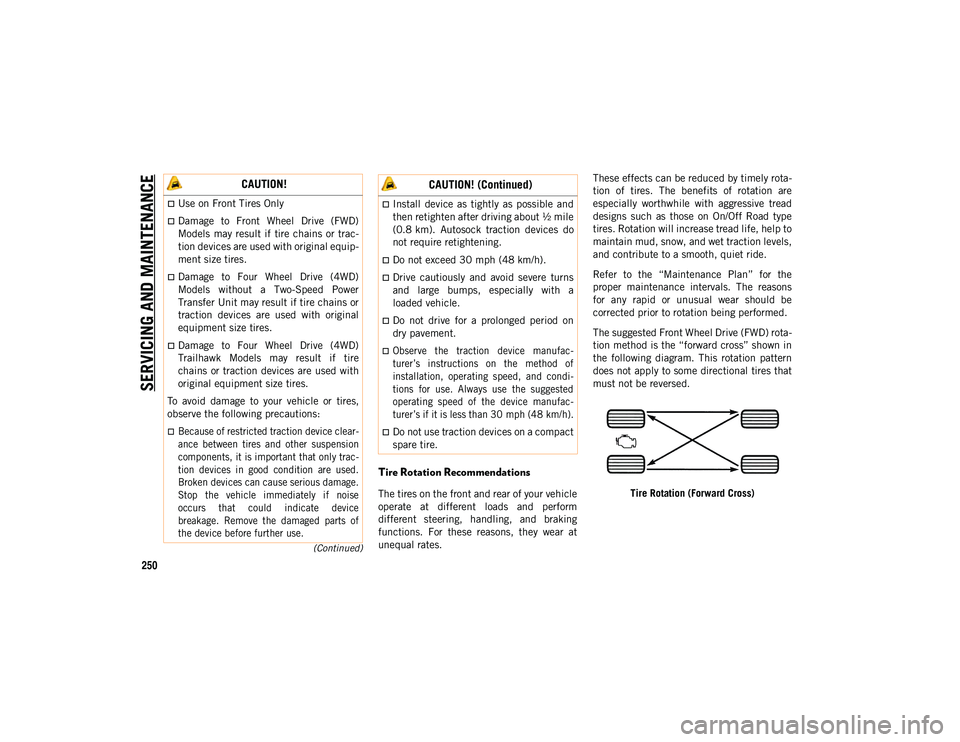
SERVICING AND MAINTENAN
CE
250
(Continued)
Tire Rotation Recommendations
The tires on the front and rear of your vehicle
operate at different loads and perform
different steering, handling, and braking
functions. For these reasons, they wear at
unequal rates.These effects can be reduced by timely rota
-
tion of tires. The benefits of rotation are
especially worthwhile with aggressive tread
designs such as those on On/Off Road type
tires. Rotation will increase tread life, help to
maintain mud, snow, and wet traction levels,
and contribute to a smooth, quiet ride.
Refer to the “Maintenance Plan” for the
proper maintenance intervals. The reasons
for any rapid or unusual wear should be
corrected prior to rotation being performed.
The suggested Front Wheel Drive (FWD) rota -
tion method is the “forward cross” shown in
the following diagram. This rotation pattern
does not apply to some directional tires that
must not be reversed.
Tire Rotation (Forward Cross)
CAUTION!
Use on Front Tires Only
Damage to Front Wheel Drive (FWD)
Models may result if tire chains or trac-
tion devices are used with original equip -
ment size tires.
Damage to Four Wheel Drive (4WD)
Models without a Two-Speed Power
Transfer Unit may result if tire chains or
traction devices are used with original
equipment size tires.
Damage to Four Wheel Drive (4WD)
Trailhawk Models may result if tire
chains or traction devices are used with
original equipment size tires.
To avoid damage to your vehicle or tires,
observe the following precautions:
Because of restricted traction device clear -
ance between tires and other suspension
components, it is important that only trac -
tion devices in good condition are used.
Broken devices can cause serious damage.
Stop the vehicle immediately if noise
occurs that could indicate device
breakage. Remove the damaged parts of
the device before further use.
Install device as tightly as possible and
then retighten after driving about ½ mile
(0.8 km). Autosock traction devices do
not require retightening.
Do not exceed 30 mph (48 km/h).
Drive cautiously and avoid severe turns
and large bumps, especially with a
loaded vehicle.
Do not drive for a prolonged period on
dry pavement.
Observe the traction device manufac -
turer’s instructions on the method of
installation, operating speed, and condi -
tions for use. Always use the suggested
operating speed of the device manufac -
turer’s if it is less than 30 mph (48 km/h).
Do not use traction devices on a compact
spare tire.
CAUTION! (Continued)
2020_JEEP_CHEROKEE_UG_RHD_UK.book Page 250
Page 253 of 332
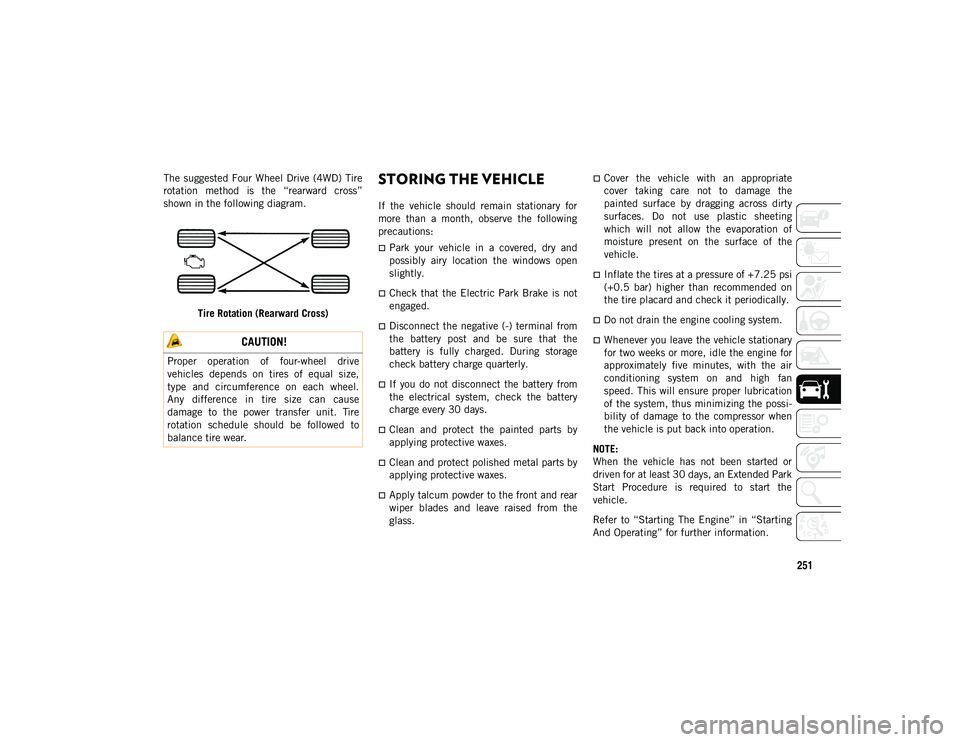
251
The suggested Four Wheel Drive (4WD) Tire
rotation method is the “rearward cross”
shown in the following diagram.Tire Rotation (Rearward Cross)STORING THE VEHICLE
If the vehicle should remain stationary for
more than a month, observe the following
precautions:
Park your vehicle in a covered, dry and
possibly airy location the windows open
slightly.
Check that the Electric Park Brake is not
engaged.
Disconnect the negative (-) terminal from
the battery post and be sure that the
battery is fully charged. During storage
check battery charge quarterly.
If you do not disconnect the battery from
the electrical system, check the battery
charge every 30 days.
Clean and protect the painted parts by
applying protective waxes.
Clean and protect polished metal parts by
applying protective waxes.
Apply talcum powder to the front and rear
wiper blades and leave raised from the
glass.
Cover the vehicle with an appropriate
cover taking care not to damage the
painted surface by dragging across dirty
surfaces. Do not use plastic sheeting
which will not allow the evaporation of
moisture present on the surface of the
vehicle.
Inflate the tires at a pressure of +7.25 psi
(+0.5 bar) higher than recommended on
the tire placard and check it periodically.
Do not drain the engine cooling system.
Whenever you leave the vehicle stationary
for two weeks or more, idle the engine for
approximately five minutes, with the air
conditioning system on and high fan
speed. This will ensure proper lubrication
of the system, thus minimizing the possi -
bility of damage to the compressor when
the vehicle is put back into operation.
NOTE:
When the vehicle has not been started or
driven for at least 30 days, an Extended Park
Start Procedure is required to start the
vehicle.
Refer to “Starting The Engine” in “Starting
And Operating” for further information. CAUTION!
Proper operation of four-wheel drive
vehicles depends on tires of equal size,
type and circumference on each wheel.
Any difference in tire size can cause
damage to the power transfer unit. Tire
rotation schedule should be followed to
balance tire wear.
2020_JEEP_CHEROKEE_UG_RHD_UK.book Page 251
Page 324 of 332
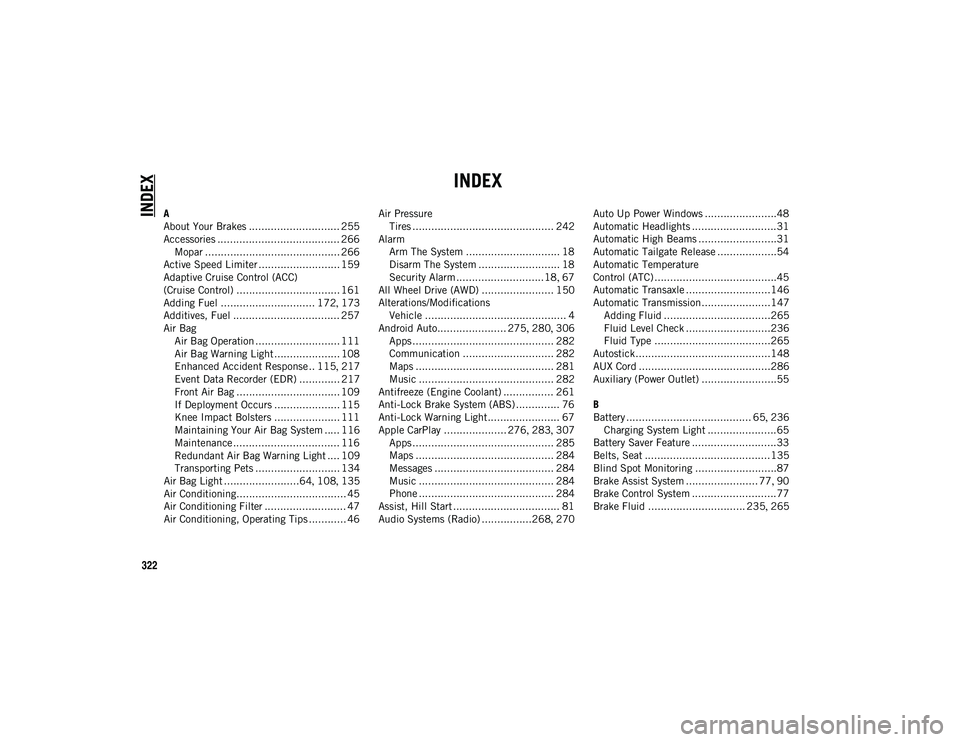
322
INDEX
INDEX
A
About Your Brakes ............................. 255
Accessories ....................................... 266Mopar ........................................... 266
Active Speed Limiter .......................... 159
Adaptive Cruise Control (ACC)
(Cruise Control) ................................. 161
Adding Fuel .............................. 172 , 173
Additives, Fuel .................................. 257
Air Bag Air Bag Operation ........................... 111Air Bag Warning Light ..................... 108
Enhanced Accident Response .. 115 , 217
Event Data Recorder (EDR) ............. 217
Front Air Bag ................................. 109
If Deployment Occurs ..................... 115
Knee Impact Bolsters ..................... 111
Maintaining Your Air Bag System ..... 116
Maintenance .................................. 116
Redundant Air Bag Warning Light .... 109
Transporting Pets ........................... 134
Air Bag Light ........................64 , 108 , 135
Air Conditioning................................... 45
Air Conditioning Filter .......................... 47
Air Conditioning, Operating Tips ............ 46 Air Pressure
Tires ............................................. 242
Alarm Arm The System .............................. 18
Disarm The System .......................... 18
Security Alarm ............................18 , 67
All Wheel Drive (AWD) ....................... 150
Alterations/Modifications Vehicle ............................................. 4
Android Auto...................... 275 , 280 , 306
Apps ............................................. 282
Communication ............................. 282
Maps ............................................ 281
Music ........................................... 282
Antifreeze (Engine Coolant) ................ 261
Anti-Lock Brake System (ABS) .............. 76
Anti-Lock Warning Light ....................... 67
Apple CarPlay .................... 276 , 283 , 307
Apps ............................................. 285
Maps ............................................ 284
Messages ...................................... 284
Music ........................................... 284
Phone ........................................... 284
Assist, Hill Start .................................. 81
Audio Systems (Radio) ................268 , 270 Auto Up Power Windows .......................48
Automatic Headlights ...........................31
Automatic High Beams .........................31
Automatic Tailgate Release ...................54
Automatic Temperature
Control (ATC) .......................................45
Automatic Transaxle ...........................146
Automatic Transmission......................147
Adding Fluid ..................................265
Fluid Level Check ...........................236
Fluid Type .....................................265
Autostick...........................................148
AUX Cord ..........................................286
Auxiliary (Power Outlet) ........................55
B
Battery ........................................ 65 , 236
Charging System Light ......................65
Battery Saver Feature ...........................33
Belts, Seat ........................................135
Blind Spot Monitoring ..........................87
Brake Assist System ....................... 77 , 90
Brake Control System ...........................77
Brake Fluid ............................... 235 , 265
2020_JEEP_CHEROKEE_UG_RHD_UK.book Page 322
Page 328 of 332
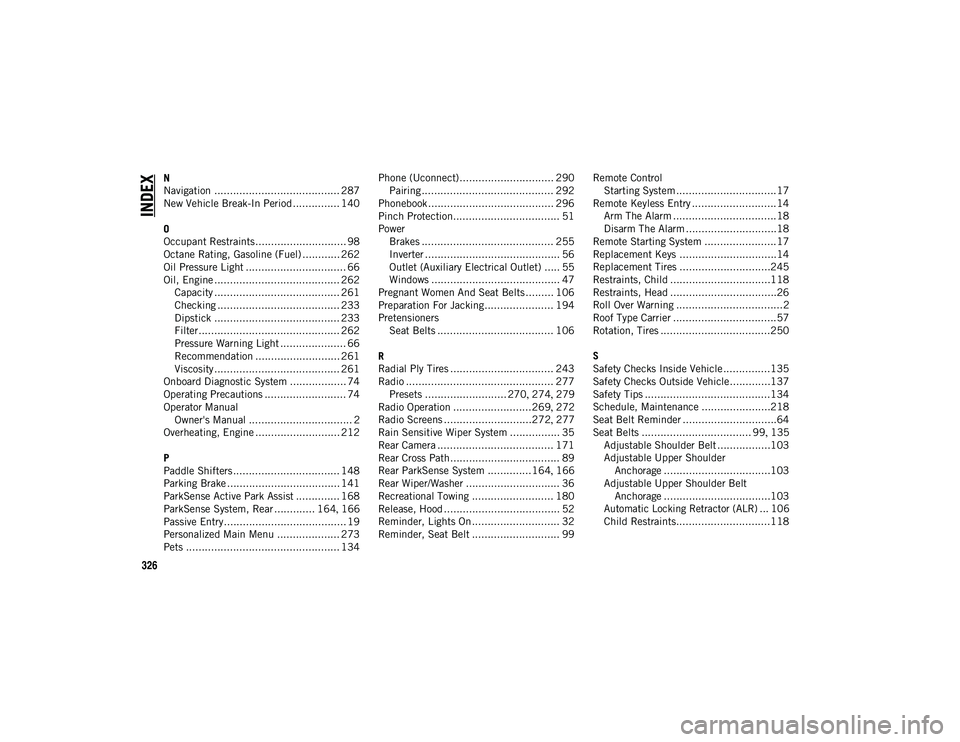
326
INDEX
N
Navigation ........................................ 287
New Vehicle Break-In Period ............... 140
O
Occupant Restraints............................. 98
Octane Rating, Gasoline (Fuel) ............ 262
Oil Pressure Light ................................ 66
Oil, Engine ........................................ 262 Capacity ........................................ 261
Checking ....................................... 233
Dipstick ........................................ 233
Filter............................................. 262
Pressure Warning Light ..................... 66
Recommendation ........................... 261Viscosity ........................................ 261
Onboard Diagnostic System .................. 74
Operating Precautions .......................... 74
Operator Manual Owner's Manual ................................. 2
Overheating, Engine ........................... 212
P
Paddle Shifters .................................. 148
Parking Brake .................................... 141
ParkSense Active Park Assist .............. 168
ParkSense System, Rear ............. 164 , 166
Passive Entry....................................... 19
Personalized Main Menu .................... 273
Pets ................................................. 134 Phone (Uconnect).............................. 290
Pairing .......................................... 292
Phonebook ........................................ 296
Pinch Protection.................................. 51
Power Brakes .......................................... 255
Inverter ........................................... 56
Outlet (Auxiliary Electrical Outlet) ..... 55
Windows ......................................... 47
Pregnant Women And Seat Belts......... 106
Preparation For Jacking...................... 194
Pretensioners Seat Belts ..................................... 106
R
Radial Ply Tires ................................. 243
Radio ............................................... 277 Presets .......................... 270 , 274 , 279
Radio Operation .........................269 , 272
Radio Screens ............................272 , 277
Rain Sensitive Wiper System ................ 35
Rear Camera ..................................... 171
Rear Cross Path................................... 89
Rear ParkSense System ..............164 , 166
Rear Wiper/Washer .............................. 36
Recreational Towing .......................... 180
Release, Hood ..................................... 52
Reminder, Lights On ............................ 32
Reminder, Seat Belt ............................ 99 Remote Control
Starting System ................................17
Remote Keyless Entry ...........................14 Arm The Alarm .................................18
Disarm The Alarm .............................18
Remote Starting System .......................17
Replacement Keys ...............................14
Replacement Tires .............................245
Restraints, Child ................................118
Restraints, Head ..................................26
Roll Over Warning ..................................2
Roof Type Carrier .................................57
Rotation, Tires ...................................250
S
Safety Checks Inside Vehicle ...............135
Safety Checks Outside Vehicle.............137
Safety Tips ........................................134
Schedule, Maintenance ......................218
Seat Belt Reminder ..............................64
Seat Belts ................................... 99 , 135
Adjustable Shoulder Belt .................103
Adjustable Upper Shoulder Anchorage ..................................103
Adjustable Upper Shoulder Belt Anchorage ..................................103
Automatic Locking Retractor (ALR) ... 106
Child Restraints..............................118
2020_JEEP_CHEROKEE_UG_RHD_UK.book Page 326